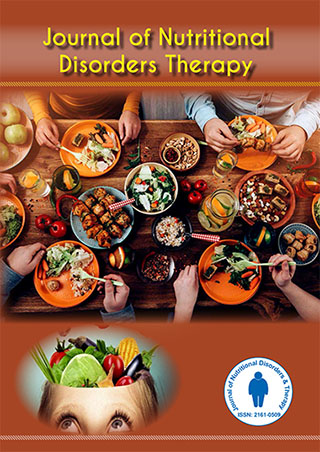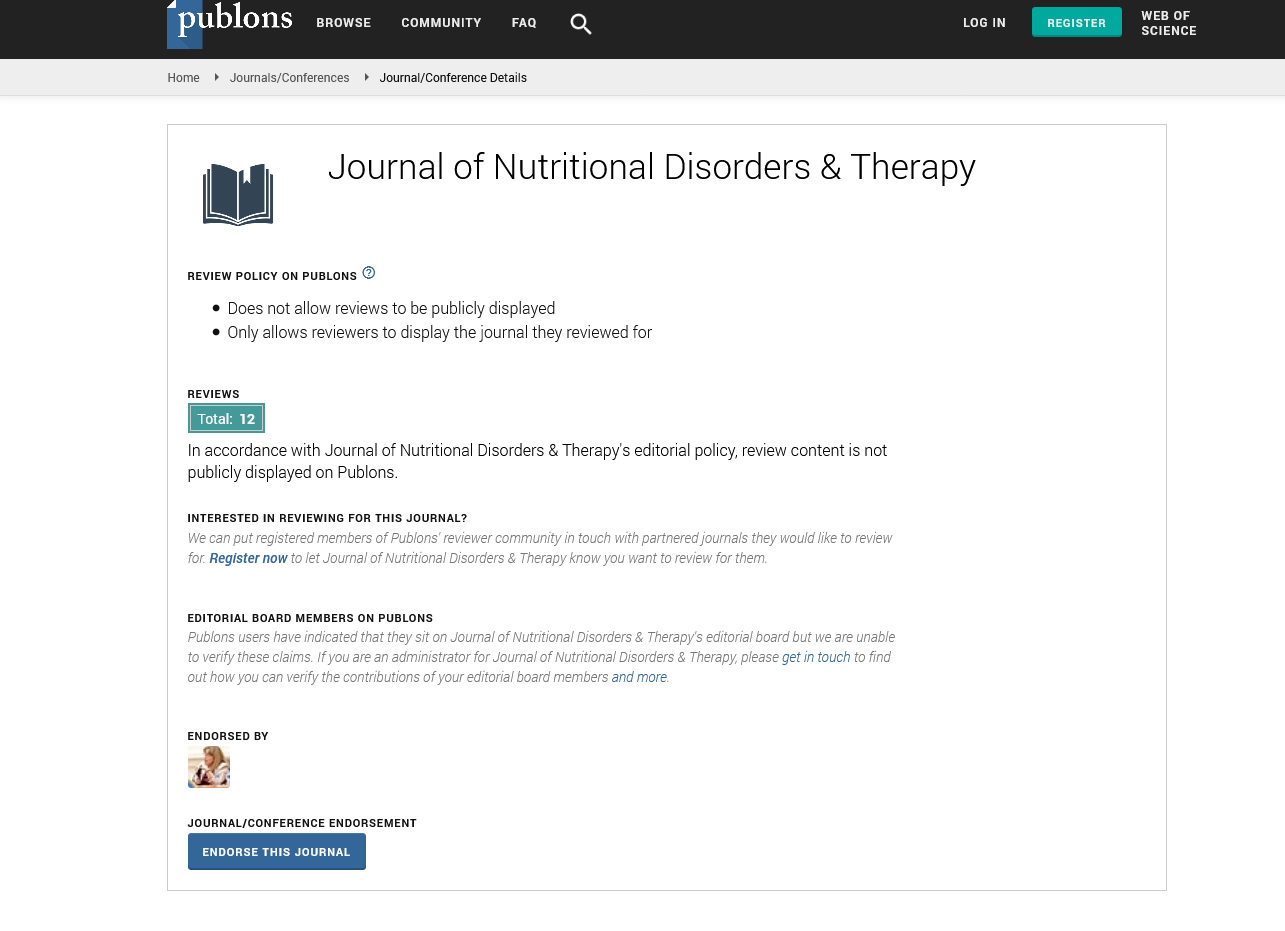Indexed In
- Open J Gate
- Genamics JournalSeek
- Academic Keys
- JournalTOCs
- Ulrich's Periodicals Directory
- RefSeek
- Hamdard University
- EBSCO A-Z
- OCLC- WorldCat
- Publons
- Geneva Foundation for Medical Education and Research
- Euro Pub
Useful Links
Share This Page
Journal Flyer

Open Access Journals
- Agri and Aquaculture
- Biochemistry
- Bioinformatics & Systems Biology
- Business & Management
- Chemistry
- Clinical Sciences
- Engineering
- Food & Nutrition
- General Science
- Genetics & Molecular Biology
- Immunology & Microbiology
- Medical Sciences
- Neuroscience & Psychology
- Nursing & Health Care
- Pharmaceutical Sciences
Opinion - (2025) Volume 15, Issue 1
Higher Nutritional Index Scores Linked to Reduced Muscle Wasting
Rong Wu*Received: 25-Feb-2025, Manuscript No. JNDT-25-29119 ; Editor assigned: 27-Feb-2025, Pre QC No. JNDT-25-29119 (PQ); Reviewed: 13-Mar-2025, QC No. JNDT-25-29119 ; Revised: 20-Mar-2025, Manuscript No. JNDT-25-29119 (R); Published: 27-Mar-2025, DOI: 10.35248/2161-0509.25.15.323
Description
Sarcopenia is a progressive condition defined by the gradual loss of skeletal muscle mass, strength and performance. Decreased mobility, increased risk of falls, metabolic dysregulation and hospitalization are common outcomes. It affects 5%-13% of older adults aged 60-70 and up to 50% of those over 80. Nutrition and immune competence are interdependent in preventing muscle loss. Malnutrition, inflammation and immune dysfunction contribute to impaired protein synthesis and myocyte degeneration.
Epidemiologic evidence
Longitudinal cohorts: In a two-year study of elderly outpatient clinic patients, each 5-point increase in Prognostic Nutritional Index (PNI) was associated with a 20% decrease in risk for incident sarcopenia. Patients recovering from hip fracture showed that higher PNI at admission predicted greater muscle mass gain over six months.
Disease-specific populations: Among patients with chronic liver disease, those with higher baseline PNI had stronger handgrip and larger thigh muscle area measured via CT, even after accounting for age and body mass index.
Biological basis of association
Protein supply and muscle synthesis: Albumin reflects adequate dietary protein intake, which supplies essential amino acids for muscle tissue. Albumin also transports hormones and amino acids critical to muscle metabolism.
Immune status and muscle preservation: Lymphocytes influence muscle regeneration by modulating satellite cells and cytokine signaling. Immune weakness can prolong inflammation, leading to proteolysis and muscle breakdown.
Inflammation and oxidative stress control: Higher lymphocyte counts are often inversely associated with systemic inflammatory markers. Chronic inflammation, indicated by high interleukin-6 and C-reactive protein, is a known driver of catabolism in muscle tissue.
Hydration and muscle volume: Serum albumin contributes to oncotic pressure and fluid distribution. Low albumin promotes edema, which may mask actual lean mass loss and interfere with functional assessments.
Clinical implications
Screening and stratification: Use of PNI can identify individuals at risk for sarcopenia, especially where full muscle imaging or strength tests are not feasible. Electronic health systems can incorporate PNI to prompt muscle-focused assessments.
Guiding nutritional intervention: Improvement of PNI through dietary protein, vitamins D and B and anti-inflammatory support can accompany resistance training. Monitoring changes in PNI during intervention may reflect treatment efficacy.
Predicting rehabilitation outcomes: In rehabilitation for hip fractures or stroke, higher PNI on admission has correlated with faster functional recovery and reduced disability.
In surgical planning: Preoperative PNI assessment may guide decisions to optimize nutritional status before orthopedic or emergency surgery, as sarcopenia increases complication rates and prolongs recovery.
Chronic illness management: Integration of PNI in care of chronic heart failure, COPD, or rheumatoid arthritis patients can guide comprehensive care, as muscle decline worsens disease prognosis.
Limitations and considerations
Acute-phase reactants: Albumin levels may fall during acute inflammation, independently of nutritional changes. In such contexts, PNI may underestimate protein status.
Variations in lymphocyte count: Lymphopenia may result from corticosteroids or chemotherapy, reducing PNI despite adequate nutrition.
Reference ranges: PNI thresholds may require adjustment based on age, sex, ethnicity, or comorbidity profiles. Local validation improves relevance.
Implementation strategies
Routine clinical use: Integrating PNI into geriatric and chronic care protocols enables early detection of muscle decline and allows timely intervention.
Surgical optimization programs: PNI assessment before elective procedures can identify surgical risk related to sarcopenia, enabling rehabilitation.
Rehabilitation and recovery: Tracking PNI during physical therapy programs offers insight into nutritional status and predicts strength gains.
Community health screening: Primary care clinics can use PNI metrics to identify individuals for lifestyle counseling to prevent sarcopenia and frailty.
Evidence indicates that higher Prognostic Nutritional Index values correspond with reduced risk and slower progression of sarcopenia. By combining simple blood tests—albumin and lymphocyte count—it provides an effective measure of nutrition, immunity, and inflammation, offering clinical value in early identification and targeted care planning. Wider adoption of PNI-driven approaches could enhance prevention and treatment of muscle loss in older adults and at-risk patients.
Citation: Wu R (2025). Higher Nutritional Index Scores Linked to Reduced Muscle Wasting. J Nutr Disord Ther. 15:323.
Copyright: © 2025 Wu R. This is an open-access article distributed under the terms of the Creative Commons Attribution License, which permits unrestricted use, distribution, and reproduction in any medium, provided the original author and source are credited.

